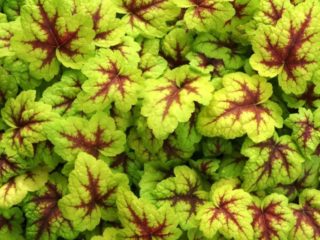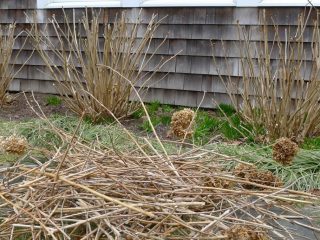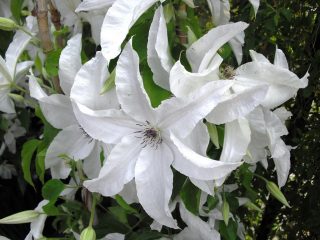Content
Heucherella Golden Zebra is a hybrid of garden plants Heuchera and Tiarella. Thanks to the extraordinary decorativeness of the foliage and ease of care, the species has gained popularity among gardeners and landscape designers.
Description of Heucherella Golden Zebra
According to the description and photo, Heucherella “Golden Zebra” is a perennial plant with bright leaf blades of a beautiful rugged shape. Of all the existing varieties, it is the most spectacular. The plant forms a cushion-shaped bush, the height of which is 30 cm, width – 45 cm. The foliage is yellow, along the veins there are ruby-colored swells. At the end of the season, in autumn, they acquire bronze shades.
Flowering of Heucherella "Golden Zebra" lasts more than two months - from June to August. Small white bell-shaped buds bloom on tall purple peduncles.
The roots are thick, located in the top layer of soil, the stems are thin, creeping, pink in color.

Heucherella "Golden Zebra" is an evergreen plant that requires shelter for the winter
Application in landscape design
The perennial Heucherella Gold Zebra remains decorative throughout the season, acquiring an even brighter appearance in the fall. Designers use this feature to decorate the garden. You can easily “fit” spectacular plants into any composition, creating a harmonious and attractive picture. Heucherella "Golden Zebra" is used in individual and group plantings. It is easy for her to find a place in mixborders consisting of both herbal and shrub plants. Hostas, daylilies, roses, and irises are good companions for Heucherella "Golden Zebra". Its combination with early bulbous plants - daffodils, crocuses, tulips - looks good. Bright leaves are spectacular in rock gardens and rock gardens.
Using an ornamental plant to create a border or frame the shore of a pond allows you to maintain an attractive landscape all season long. Heucherella "Golden Zebra" grows well in containers. They are placed anywhere in the garden and moved, if necessary, to the gazebo, veranda and to the entrance to the house.
Features of reproduction
Heucherella "Golden Zebra" can be propagated in two ways - using cuttings and dividing the rhizome.
Cuttings
Young green shoots of the current year are needed for division. They are cut in the first ten days of April, dipped in a container of water, and a growth stimulator is added to speed up the process of root formation. After a month, roots appear on the shoots. “Golden Zebra” cuttings are planted in pots filled with fertile soil mixture. Transplantation to a permanent place is carried out at the moment when the plant begins active vegetation.

Flowering time for Heucherella is June-August
By division
The procedure for dividing the rhizome of Heucherella "Golden Zebra" should be carried out at least once every 4 years. Otherwise, it loses its decorative effect, the tops dry out, and the shoots stretch out.
After being removed from the soil, the rhizome is washed, all dry stems are removed, divided into parts so that each has a living bud, and planted in a permanent place.
Planting and care
Heucherella "Golden Zebra" is an unpretentious plant. In order for it to have a bright, beautiful and healthy appearance, you should select the soil and place for planting, and perform simple care, consisting of periodic watering, fertilizing, and controlling diseases and pests.
Recommended timing
Young seedlings of Heucherella "Golden Zebra" are planted in the ground after the frosts end and warm weather sets in. In the middle zone, this period begins at the end of May.
You can start dividing the bushes from the second ten days of July until August 10. Plants have time to bloom and take root before frost.
Site selection and soil preparation
Heucherella "Golden Zebra" develops well on fertile soils with a loose structure. The acidity of the soil should be neutral or slightly alkaline (pH 6.0 - 6.5). Drainage is arranged at the planting site so that excess moisture can drain out. Due to the shallow root system of the plant, soil is selected with moisture-absorbing properties that can retain water in sufficient quantities for nutrition.
For planting, choose an area illuminated by the sun in the morning and shaded the rest of the time. Without sunlight, the leaves do not acquire bright colors and become faded.Constant exposure to the sun leads to a depressed state of the plant, its drying out and death.

Hilling of Heucherella "Golden Zebra" is carried out annually
Landing algorithm
After choosing a site, planting begins:
- Prepare pits with a width and depth of 30 cm.
- A drainage layer is made from expanded clay, broken brick or crushed stone.
- Garden soil is used as a substrate, to which ash, humus or compost are added.
- Before planting, dry and damaged shoots are removed from seedlings and the roots are shortened.
- Fresh sections are treated with crushed coal.
- Place the bushes in the center of each hole.
- Sprinkle with soil and water.
- Plantings provide shade.
Watering and fertilizing schedule
After planting, Heucherella "Golden Zebra" requires regular watering. Both overdrying the soil and stagnant moisture, which can lead to rotting and death of the root system, are harmful to the plant. In hot summers, watering is carried out at intervals of 1 to 3 times a week. When moistening, it is necessary to ensure that drops do not fall on the foliage and subsequently cause burns. After moistening the soil, it is loosened shallowly so as not to damage the surface roots, and then mulched with peat, grass clippings and leaves.
Heucherella "Golden Zebra" is an unpretentious plant that can grow in poor soils, but in order for the foliage to look as impressive and decorative as possible throughout the season, fertilizing is necessary. On soils rich in organic matter, no fertilizer is applied in the first year after planting. In subsequent years, mineral complexes are used. Fertilizer is used twice - at the beginning of the growing season and after flowering. The recommended fertilizing rate is 20 g/m2.
Transfer
After several years of growth in one place, Heucherella "Golden Zebra" can change its original appearance - the leaves lose their brightness, fall off, and the shoots stretch out. Its roots are often exposed, reaching the surface of the soil, which leads to freezing of the plant. In this case, transplantation or rejuvenation of the bush by division is necessary.
If the procedure is carried out in the spring, heucherella quickly takes root, adapts to new conditions, and begins active growth. After transplantation in late autumn, it needs reliable shelter for the winter.

In the shade, heucherella turns green, losing its bright color
Wintering
Heucherella "Golden Zebra" has moderate winter hardiness. It needs to be prepared for the coming frost. For this purpose, the rosettes are hilled, mulched and covered with non-woven material. In addition to protection from low temperatures, it is necessary to protect Heucherella “Golden Zebra” from sunburn. In winter, evergreen foliage actively evaporates moisture, and the roots are dormant and are not able to fully provide it with moisture. Without organizing foliage cover, a “physiological drought” may occur, which can weaken the plant due to burns.
The material is removed gradually in cloudy weather. To stimulate the activity of the root system, it is recommended to water the bushes with warm water.
Diseases and pests
Heucherella "Golden Zebra" is resistant to diseases, but if agricultural practices are violated or unfavorable weather conditions, powdery mildew or brown spot may occur. The risk of disease increases if infected plants are nearby.
To eliminate the white coating that appears with powdery mildew, treat with fungicides. To combat brown spot, preparations containing copper are used.
Among the most dangerous pests of Heucherella "Golden Zebra" are the grooved weevil and slugs. The first destroys the roots, leading to the death of the plant. To combat it, mustard powder is used, the solution of which is sprayed on the foliage. Consumption rate – 1 tbsp. l. per liter of water.
Slugs gnaw through leaf blades, leaving white marks on them. Fluffy lime, which is scattered under the bushes in the morning or evening, during the period of maximum slug activity, will help scare them away from the area.
Conclusion
Heucherella Golden Zebra does not require careful care, grows quickly, and looks beautiful. By placing it in your garden, you can give it a spectacular look and emphasize its uniqueness.








